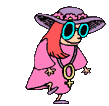
 |
THE LAST GATHERING OF BEATS POETS & ARTISTS, CITY LIGHTS BOOKS North Beach, San Francisco 1965Lawrence Ferlinghetti wanted to document the 1965 Beat scene in San Francisco in the spirit of the early 20th century classic photographs of the Bohemian artists & writers in Paris.The Beats, front row L to R: Robert LaVigne, Shig Murao, Larry Fagin, Leland Meyezove (lying down), Lew Welch, Peter Orlovsky. Second row: David Meltzer, Michael McClure, Allen Ginsberg, Daniel Langton, Steve (friend of Ginsberg), Richard Brautigan, Gary Goodrow, Nemi Frost. Back row: Stella Levy, Lawrence Ferlinghetti. Because this is a vertical image about half of the Beats attending are not shown. |
Allen Ginsberg, Bob Donlon (Rob Donnelly, Kerouac’s Desolation Angels), Neal Cassady, myself in black corduroy jacket, Bay Area poets’ “Court Painter” Robert La Vigne & poet Lawrence Ferlinghetti in front of his City Lights Books shop, Broadway & Columbus Avenue North Beach. Donlon worked seasonally as Las Vegas waiter & oft drank with Jack K., Neal looks good in tee shirt, Howl first printing hadn’t arrived from England yet (500 copies), we were just hanging around, Peter Orlovsky stepped back off curb & snapped shot, San Francisco spring 1956, 1956, gelatin silver print, printed 1984–97, 11 1/8 x 16 3/4 in. (28.3 x 42.6 cm), National Gallery of Art, Gift of Gary S. Davis. © 2012 The Allen Ginsberg LLC. All rights reserved.
“He looked by that time like his father, red-faced corpulent W.C. Fields shuddering with mortal horror…” Thus reads the inscription of a photo depicting American icon Jack Kerouac and taken by Allen Ginsberg in 1964 — just a few years before the former’s death. Far from the exuberant youth depicted in earlier photos, this portrait offers an entirely different image of Kerouac: that of the aging alcoholic, slumped dejectedly in a battered armchair.
Beat Memories presents an in-depth look at the Beat Generation as seen through the lens of Allen Ginsberg (1926–1997). Although well known for his poetry, Ginsberg was also an avid photo- grapher, capturing the people and places around him in spontaneous, often intimate snapshots. His black-and-white photographs include portraits of William S. Burroughs, Neal Cassady, Gregory Corso, Jack Kerouac, and others, along with self-portraits. The images not only are revealing portrayals of celebrated personalities, but also convey the unique lifestyle and spirit of the Beats
The Beat movement, also called Beat Generation, American social and literary movement originating in the 1950s and centred in the bohemian artist communities of San Francisco’s North Beach, Los Angeles’ Venice West, and New York City’s Greenwich Village. Its adherents, self-styled as “beat” (originally meaning “weary,” but later also connoting a musical sense, a “beatific” spirituality, and other meanings) and derisively called “beatniks,” expressed their alienation from conventional, or “square,” society by adopting an almost uniform style of seedy dress, manners, and “hip” vocabulary borrowed from jazz musicians. Generally apolitical and indifferent to social problems, they advocated personal release, purification, and illumination through the heightened sensory awareness that might be induced by drugs, jazz, sex, or the disciplines of Zen Buddhism. Apologists for the Beats, among them Paul Goodman, found the joylessness and purposelessness of modern society sufficient justification for both withdrawal and protest.
Beat poets sought to liberate poetry from academic preciosity and bring it “back to the streets.” They read their poetry, sometimes to the accompaniment of progressive jazz, in such Beat strongholds as the Coexistence Bagel Shop and Lawrence Ferlinghetti’s City Lights bookstore in San Francisco. The verse was frequently chaotic and liberally sprinkled with obscenities but was sometimes, as in the case of Allen Ginsberg’s Howl (1956), ruggedly powerful and moving. Ginsberg and other major figures of the movement, such as the novelist Jack Kerouac, advocated a kind of free, unstructured composition in which the writer put down his thoughts and feelings without plan or revision—to convey the immediacy of experience—an approach that led to the production of much undisciplined and incoherent verbiage on the part of their imitators. By about 1960, when the faddish notoriety of the movement had begun to fade, it had produced a number of interesting and promising writers, including Ferlinghetti, Gregory Corso, Philip Whalen, and Gary Snyder, and had paved the way for acceptance of other unorthodox and previously ignored writers, such as the Black Mountain poets and the novelist William Burroughs.


















